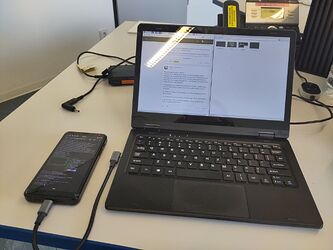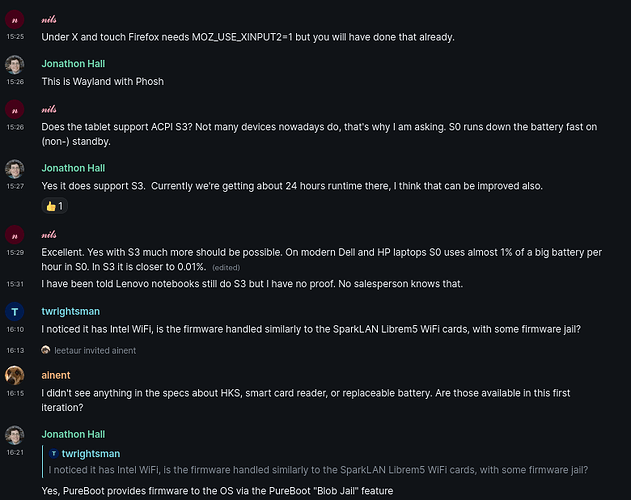I got an email from Purism Investor Relations, but I will truncate the email to keep it relevant to this thread.
I was originally kind of excited about this, but then I saw the size of the thing. It is gigantic compared to normal tablet sizes. I think 11 or 10" is probably the sweet spot. See using a giant tablet is just silly to me, I would rather just have a laptop since the space taken up is no more or less than a laptop in that case.
Do you have a picture of the L11?
I own three Acer C720 Chromebook laptops, which have as display: 11.6" TN 1366x768. 220 nits, i.e. more or less as in your picture. They run all FreeBSD, maybe I should at least in one of them install PureOS…
My children have both an iPad with 10.2" display.
Why a L11 is bad for you, tablets are of this size today.
I wasn’t referring to the L11, but was talking about the Starlabs tablet that is basically 13". I think the L11 is very compelling, at least at this point without any details.
I see now, that I got your posting wrong because it showed up below the latest news about L11. Sorry for this.
No worries! I edited my post to make this more clear.
We would be so in on this one. We use 11 tablets all day every day - but NFC would be something of a dealbreaker….
I had been mixed about whether or not I would pick one up. A recent use-case I came up with that would push me toward picking one up would be having a device where I can display a recipe while I cook. The Librem 14 is too bulky to set in the kitchen and the Librem 5 is too small. I hope there is an option for a stand, preferably the kind that also acts as a cover.
The L11 is now announced in Purism’s store: Purism– Librem 11
Librem 5 + lapdock? (You can choose from a range of sizes for a lapdock, from about 11" to about 15", depending on your requirement but maybe the lower end is what you want.)
Alternatively you could DIY using e.g. a portable monitor of whatever size you want, and with or without touchscreen capability, with a Raspberry Pi. (I basically have this for one application that I have and the portable monitor comes with a stand of sorts.)
But, yes, maybe the Librem 11. It looks as if the keyboard is the stand.
If you are going to use a cover then you need to consider how a touchscreen (and likewise keyboard) would play with that - but my feeling is that cooking and touchscreen are not a good combination. ![]()
I’m torn on what I think about this tablet being announced. It looks neat! Really neat! But one of the big draws to the Librem5 for me was convergence- The idea of a single secure device that I could use in different form factors via docking.
I don’t really know if I’d buy a second device when what I’ve got works so well in my various use cases (I have docking stations at work arranged for different work needs, a more robust entertainment docking station in my living space, a smaller one in my kitchen for when I’m streaming cooking, etc). Maybe if someone finds a way to use it as a smaller “lapdock” like device for the phones I’ll grab one.
I think it is clear what the purpose of the Librem 11 is good for: drawing and upgradeable storage. It also uses x86-64: applications are more widely supported in comparison to the Librem 5. For example: Mullvad Browser and Tor Browser.
I do find this device interesting, particularly as it’s using a x86 processor.
Side questions I have based on the description:
- Does it not have speakers at all?
- There’s mention that the librem key works with it. As I thought there wasn’t a USB-C librem key, and it appears to have only USB-C connectors for it, I’m confused…
- I don’t see where it talks about the battery, so it’s hard to even estimate the battery life potential.
- No mention of hardware kill switches, which seems to be Purism’s main thing(just thought it was odd, though I’m not sure I care in this case).
- On the software end, Does this come with more of a phone image or a laptop image (Is one expected to use phosh or gnome?)?
Mentioned in the other “on topic” thread.
No hardware kill switches; they are also absent on the Librem Mini and Librem Server.
- On the software end, Does this come with more of a phone image or a laptop image (Is one expected to use phosh or gnome?)?
Wayland with Phosh.
This is Wayland with Phosh
- Does it not have speakers at all?
- There’s mention that the librem key works with it. As I thought there wasn’t a USB-C librem key, and it appears to have only USB-C connectors for it, I’m confused…
Contact Purism support for your remaining inquiries, or alternatively join the conversation in the Matrix chat rooms.
General questions
To: support@puri.sm
What: explanations and additional information about Purism products, services or software, if these are not provided already on our website or wiki, or simply not clear enough.
- This is not meant as a replacement for the support@ and ops@ addresses (see further below).
- Before sending questions to “info”, please first check our website: general , products , phone , FAQ and wiki pages, your question may be already answered!
Subject: [product or service] question summary
Usual response time: under 24 hoursExample email subject: [Librem laptops] SSD models in Librems
Therefore, there are no HKS and the back is not really removable. It is glued so you can remove it but may damage it. Things become serviceable inside when the back is removed. The RAM is soldered but the drive is an NVMe card that can be replaced. Not fully sure about the battery, but I think it is removable too.
I’m leery to buy a device with a glued-on back cover, because eventually the battery will wear out and need to be replaced. I have never had an SSD fail on me, but I still want to be able to extract the SSD in case the tablet fails or I ever need to upgrade.
I would be reluctant to try and remove the Librem 11’s back cover, because the device is only 6mm thick. That is thinner than most phones, which worries me, because I have taken apart thin phones and it is easy to damage them in the process. It requires a hair dryer, suction cups, a couple guitar picks and a lot of patience. The batteries are usually soldered in and glued in when phones are that thin, and some phones have wires that you can break if you pry from the wrong side side of the case. I would like to see a teardown of the Librem 11 to see how hard it is to open up.
Sadly nearly all the other models of x86 tablets on the market use a similar type of design. The only x86 tablets with a removable battery that I can find are the Dell Latitude 7220 Rugged Extreme Tablet and the Teguar Rugged Windows Tablets. The Latitude 7220 starts at $1386 and has an 8th gen i3 processor which was first launched in Q3 2018, so it is out of date. The Teguar TRT-5380-10 has the same processor and same amount of RAM as the Librem 11, but its 10.1" model with 128GB of storage starts at $1145.
I am divided about this. Obviously Purism is rebadging an ODM device, which is why Purism can offer this device at a reasonable price. The downside is that Purism has to use a standard ODM design, which means a glued on back cover, soldered RAM, soldered WiFi/BT, no hardware kill switches and a device which is too thin to be easily opened and serviced.
On the other hand, a custom design means an expensive device, a long wait time for it to come to market, and the risk of encountering bugs in the design. Given the problems that Purism has had with custom hardware in the past, I glad that the company is playing it safe and using an ODM design. At this point, I believe that Purism needs to avoid taking any major risks for a while to rebuild its reputation with its customers after the L5 problems. I admire Purism for daring to design custom hardware, but I don’t think that the demand for a Linux tablet is high enough to justify the risk that entails, especially if Purism had used the i.MX 8M Quad processor, which has weak specs compared to an Intel N5100.
Having said all that, my dream would be a custom-designed ARM tablet with a Rockchip RK3588 processor and 16GM RAM, because that would be powerful enough to replace my current laptop and it has amazing video out to use as a convergence device. Oh well, we can dream.
In the meantime, I’m still glad that Purism is offering something to compete with the Juno Tab 2, StarLabs StarLite and PINE64 PineTab2. Considering that we had no Linux tablets on the market a couple years ago, I really happy to see that there will be four different Linux models on the market by the end of this year.
I am divided about this.
I have a clear and firm stance about Purism products: crowdfunded bespoke product designs are great; accessible white-labeled products with value-added services towards security/privacy are good. Therefore, the Librem 11 is well defined in the latter group: a Linux tablet using PureOS with Coreboot + Heads; it shares many similarities with the Librem Mini.
There’s mention that the librem key works with it. As I thought there wasn’t a USB-C librem key, and it appears to have only USB-C connectors for it, I’m confused…
You are not the only one asking about this.
At the end of the day though USB-A and USB-C should interoperate perfectly with the use of a small adapter. Hence, for example, with the Librem 5 (only a USB-C port), you can plug a M-F USB-A adapter in the bottom of the phone and plug e.g. a USB-A flash drive into that.
For ongoing use that wouldn’t be much good with the Librem 5 and, in that scenario, I feel that you are likely not to want to enable the option that locks the device when the Key is removed.
Purism controls the manufacturing of the Librem Key,* so it shouldn’t be hard for the company to produce a version of the key with a USB-C port.
The bigger question is how fast can Purism port Coreboot+Heads to the Librem 11 without Matt DeVillier (aka MrChromebox) as an employee. I don’t see any commits by Jonathan Hall to Coreboot about the Librem 11, although I see that that DeVillier made a commit in August to add power limits for the Intel N5100, which is the Librem 11’s processor, so DeVillier may still be helping Purism although he has been working for AMD since July 2022.
* In 2019, Purism reported, “We will be manufacturing the Librem Key v2 in the same US facility where we manufactured our Librem 5 devkits”, which was “in the San Diego area”.

